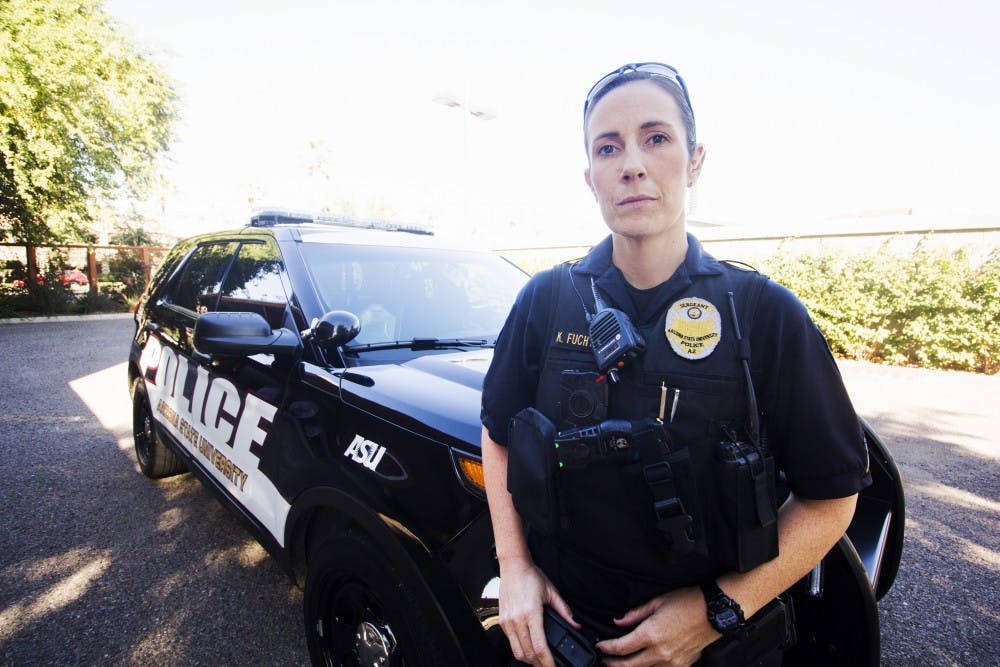To ensure transparency among officers, ASU Police and the public they encounter will be on camera after the department distributes and implements body cameras on Nov. 6.
ASU police officers have gone through weeks of training before the cameras were deployed in the field, ASU Police spokesperson Nicole Franks wrote in an email.
“One of Police Chief Michael Thompson’s goals is transparency of the department for the public, and implementing body cameras is another step in that direction,” she wrote.
According to Scottsdale-based company Taser International ASU’s camera order is the third largest deployment of their Axon Body camera, which was launched in 2013 and is used by officers in more than 30 American universities.
Taser spokesman Steve Tuttle said ASU purchased 80 Axon Body camera units at roughly $400 per camera, which includes a five-year license to Evidence.com — a cloud-based data storage site for camera feeds and other case evidence.
“Once on duty, the camera is always rolling,” Tuttle said, citing the stand-by style pre-record mode, which, when the record button is pushed, also includes the footage captured 30 seconds before the intended recording.
“The footage can be played back instantly using the Evidence.com application on a cellphone,” he said. This allows for instant review before cameras are charged at the end of a shift while they upload data to the cloud for further analysis.
The purchase price for the 80 cameras is around $32,000, but Franks said costs for data analysis and future access to the program are not accounted for in the initial per-camera price.
“It’s not just storage,” Tuttle said, “It’s management of case file information,” which he said includes, but is not limited to, officer body cam videos, pictures and other case-specific evidence to be indexed and searched.
Franks said ASU police officers are generally pleased with the new cameras, and that “it gives an unbiased view of what is happening.”
Several body cam studies, including one published in late 2014 by ASU professors who focused on a group of police officers in Phoenix, have shown that use-of-force situations and complaints against officers decreased when cameras were present.
Body cam videos and information on Evidence.com are available for case prosecutors and police to access, and are deemed public records when a case is no longer active.
‘It’s like using your online banking account, only more secure,” Tuttle said.
ASU’s decision to implement body cameras is a new step for the school, but it is not unique to other police departments in cities or universities.
The University of Arizona is number six on the list of universities with the most Taser cameras after it ordered 58 of them for its officers, who received them the first week of November.
Northern Arizona University police officers have cameras as well — video footage of the moments following the Nov. 9 campus shooting was captured on officer body cams.
This change for ASU also corresponds with a nationwide trend toward equipping more police with body cams. According to the Bureau of Justice Assistance website, the United States Department of Justice financed the $19.3 million purchase of 21,000 body cameras for police departments in 32 states. In Arizona, the cities of Glendale and Peoria, as well as the Salt River Pima-Maricopa Indian Community received federal grant money to purchase body cameras.
David Ryan, a journalism senior at ASU, said he has mixed feelings about the police camera program.
“It adds a level of accountability for the community, for both officers and students,” Ryan said. “I think it’s a great tool for the police department.”
However, Ryan said one issue with the program is that ASU’s police department is not completely in control of the data acquired by the cameras.
Video footage from Taser’s cameras is uploaded to Evidence.com, which is also owned by Taser.
“I’m a little concerned that a private company is going to be in control of public records,” he said, adding that it creates a level of complexity if records aren’t totally public because they are in private hands.
Tuttle said Taser does not have the authority to access police records, and that any copies, edits or changes to data on evidence.com can only be made by police administration.
Ryan said he thinks the program will make a difference, but that ASU needs to “find a way to be transparent and accessible with the information.”
Reach the reporter at jesse.stawnyczy@asu.edu or follow @jesse_etcetera on Twitter.
Like The State Press on Facebook and follow @statepress on Twitter.




